Did you know that Canna ‘Cleopatra’ is not just an ordinary garden flower? It belongs to the family of exotic plants known for their tropical foliage and stunning blooms. If you’re looking to add a touch of vibrancy and beauty to your garden, Canna ‘Cleopatra’ is the perfect choice. In this article, I will share valuable care tips specifically tailored for UK gardeners, helping you successfully grow and maintain this ornamental plant with its perennial blooms. Discover the secrets to creating a stunning garden design and stay up to date with the latest landscaping trends. Whether you’re a seasoned gardener or a beginner, let’s delve into the world of Canna ‘Cleopatra’ and unlock its botanical wonders.
Appearance of Canna ‘Cleopatra’ (Canna Lily)


Canna ‘Cleopatra’ is a semi-dwarf variety of canna lily that brings a distinctive charm to any garden with its striking height of roughly 90-120 cm. This variety is particularly noted for its unique and textured blooms, which captivate the eye with their vivid streaks, speckles, and bold blocks of colour. The flowers themselves are a mesmerising fusion of yellow, beautifully interspersed with speckles of a deep bronze-red, creating a display that is both fiery and impossible to overlook.
Beyond its enchanting flowers, Canna ‘Cleopatra’ boasts lush, tropical-looking foliage that adds an additional layer of appeal. This foliage, rich and green, provides a perfect backdrop for the colourful blooms, enhancing their visual impact and contributing to the plant’s overall exotic allure.
The appearance of Canna ‘Cleopatra’ makes it a standout choice for gardeners looking to introduce a touch of the dramatic and the tropical into their outdoor spaces. The semi-dwarf stature of the plant ensures that it fits beautifully into a variety of garden designs, from borders to focal points, without dominating the landscape.
The unique beauty of Canna ‘Cleopatra’ lies in its ability to combine the fiery, eye-catching hues of its blooms with the lush, verdant elegance of its foliage. This combination results in a plant that not only adds colour and texture but also brings a hint of tropical paradise to temperate garden settings. For anyone wishing to create a garden that captures attention and sparks conversation, Canna ‘Cleopatra‘ is an impeccable choice, offering a visual feast that celebrates the exotic and the vibrant.
 Did you know that Canna ‘Cleopatra’ has a historical charm? It’s believed that cannas were grown in the gardens of Henry VIII at Hampton Court, adding a regal splendour. This makes the Canna ‘Cleopatra’ not just a plant for your garden, but a living piece of history, connecting modern gardeners with the botanical passions of the past.
Did you know that Canna ‘Cleopatra’ has a historical charm? It’s believed that cannas were grown in the gardens of Henry VIII at Hampton Court, adding a regal splendour. This makes the Canna ‘Cleopatra’ not just a plant for your garden, but a living piece of history, connecting modern gardeners with the botanical passions of the past.
Light Requirements for Canna ‘Cleopatra’


Canna ‘Cleopatra’ is a versatile and stunning variety of canna lily that thrives in different light conditions. To ensure optimal growth and blooming, it is best to plant them in an area that receives at least 6-8 hours of direct sunlight per day. This variety loves basking in the full sun, which promotes healthy growth and vibrant blooms.
However, Canna ‘Cleopatra’ is also known for its shade tolerance, making it a great choice for gardens with light shade conditions. It can handle some respite from the hot sun, making it adaptable to a variety of outdoor spaces. Therefore, it’s a wonderful addition to any garden, whether it’s drenched in sunlight or cast in partial shade.
When selecting the planting location for your Canna ‘Cleopatra’ plants, it’s important to consider the light requirements. Ensure that the chosen spot provides the necessary sunlight to fuel healthy growth and vibrant blooms. A well-lit area that receives ample direct sunlight will allow these garden flowers to flourish, beautifying your garden with their tropical foliage and exotic appearance.

Watering Tips for Canna ‘Cleopatra’ (Canna Lily)
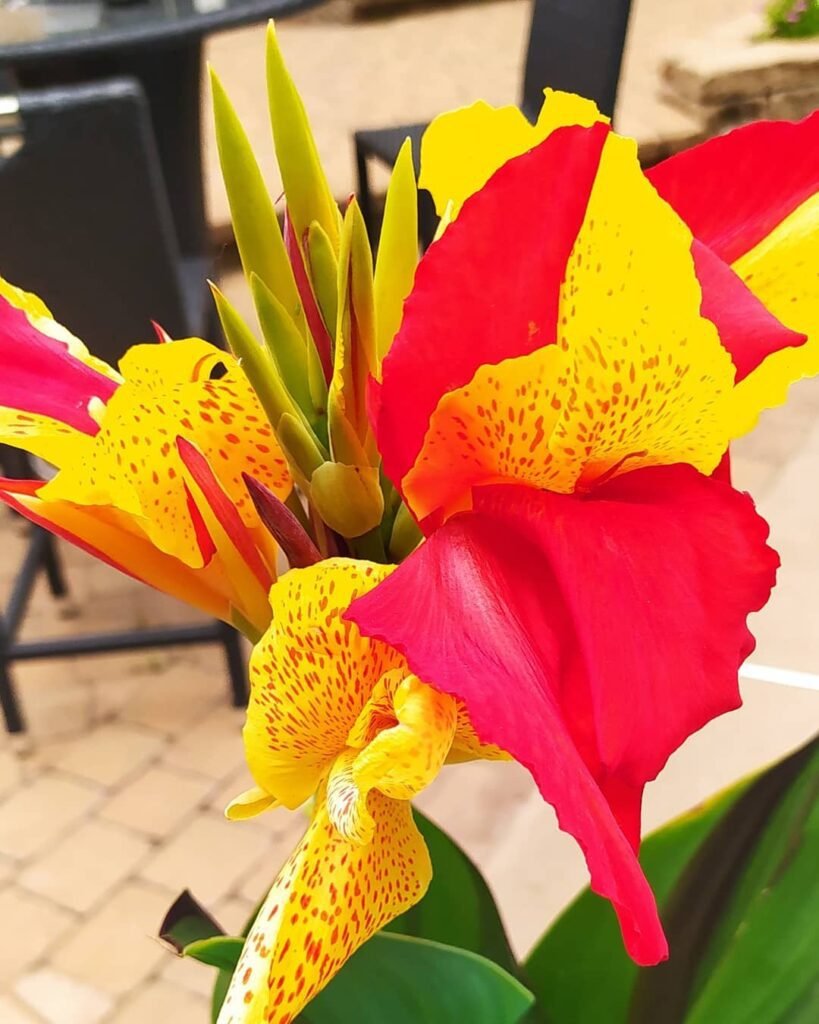
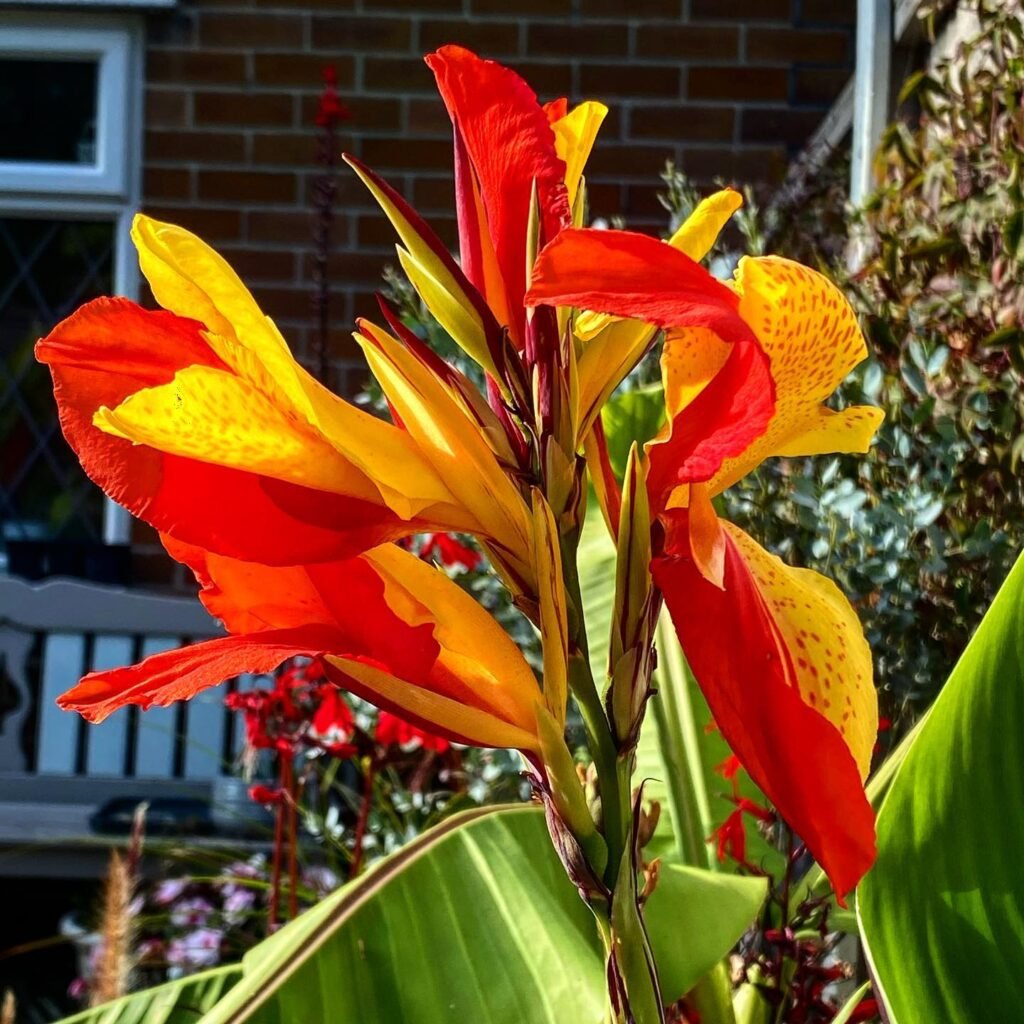
Proper watering is crucial for the healthy growth and blooming of Canna ‘Cleopatra’ plants. In this section, I will provide you with useful tips on watering your canna lilies to ensure their optimal performance in your garden.
- Thorough watering: Canna ‘Cleopatra’ prefers moist soil conditions, so it’s important to water the plants thoroughly. Ensure that the water penetrates deep into the soil to reach the root zone of the plants. This will help promote healthy root development and overall growth.
- Consistent watering: Consistency is key when it comes to watering canna lilies. Aim to water your plants regularly, especially during the hot summer months when evaporation rates are higher. Providing a consistent water supply will help prevent the plants from drying out and ensure continuous growth and flowering.
- Watering frequency: Canna ‘Cleopatra’ plants generally require about 1-2 inches of water per week. This can be achieved through a combination of rainfall and manual irrigation. However, it’s important to monitor the moisture levels in the soil to avoid overwatering or underwatering.
- Soil moisture: To maintain the right moisture level in the soil, regularly check the soil with your finger or a moisture meter. The top inch of the soil should feel slightly dry before you water the plants again. This will prevent the risk of overwatering, which can lead to root rot and other water-related issues.
- Early morning watering: It’s best to water your canna lilies in the early morning. This allows the foliage to dry out during the day, reducing the risk of fungal diseases. Avoid watering in the late afternoon or evening, as wet foliage overnight can increase the chances of diseases.
Remember, it’s important to strike the right balance with watering canna ‘Cleopatra’ plants. While they prefer moist soil, they can tolerate some dry spells. By following these watering tips, you can ensure the health and vitality of your canna lilies, allowing them to thrive and brighten up your garden with their tropical foliage and beautiful blooms.

Fertilizing and Soil for Canna ‘Cleopatra’


Canna ‘Cleopatra’ is an exquisite canna lily variety that thrives in the UK climate. To ensure the health and vitality of your Canna ‘Cleopatra’ plants, it is essential to provide them with the right soil conditions and nutrients.
Soil Preparation
I highly recommend preparing the soil before planting Canna ‘Cleopatra’. This variety thrives in rich, moisture-retentive soil that is high in organic matter. To achieve this, amend the soil with organic matter such as compost or well-rotted manure. This will improve the soil’s fertility and water-holding capacity, helping the plants establish strong roots and lush foliage.
Organic Fertilizers
Fertilizing your Canna ‘Cleopatra’ plants with organic fertilizers is crucial for their growth and development. Incorporating a balanced slow-release fertilizer into the soil will provide the necessary nutrients for optimal blooming. Organic fertilizers not only nourish the plants but also improve soil health and promote beneficial microbial activity. Repeat the fertilization process every 4-6 weeks during the growing season to ensure continuous nourishment and vibrant blooms.
Outdoor Plants Considerations
When growing Canna ‘Cleopatra’ outdoors, it’s important to consider the specific needs of outdoor plants. Exposure to the elements, such as rain and wind, can leach nutrients from the soil. Regular fertilization helps replenish the lost nutrients and supports the plants’ overall health and vigor.
Tip: When applying fertilizers, follow the manufacturer’s instructions for recommended dosage and application methods. Always water the plants after fertilization to ensure proper nutrient absorption.
By preparing nutrient-rich soil and providing organic fertilizers, you can create an ideal growing environment for your Canna ‘Cleopatra’ plants. Remember to monitor their growth and adjust the fertilization accordingly to ensure beautiful blooms and healthy tropical foliage.

Pruning and Maintenance for Canna ‘Cleopatra’
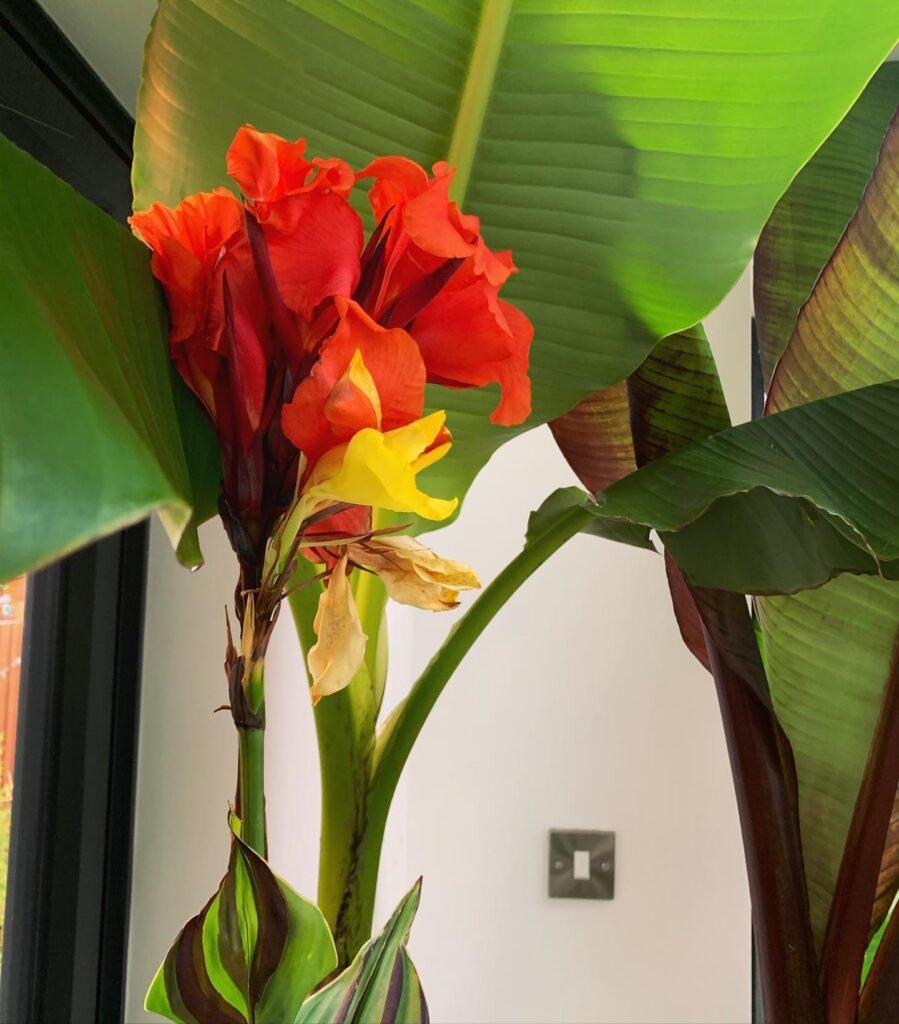

Pruning canna ‘Cleopatra‘ is generally not necessary unless the plant becomes overgrown or starts to look untidy. However, if desired, you can remove old or faded blooms to promote a neater appearance and potentially encourage additional flowering. Additionally, removing any dead or damaged foliage can help maintain the overall health of the plant.
“Removing faded blooms can promote neater appearance and encourage additional flowering.”
Regular inspection for pests and diseases is also important as it allows you to address any issues promptly, thus preventing further damage and maintaining the plant’s vitality.
“Regular inspection for pests and diseases is crucial in keeping Canna ‘Cleopatra’ healthy.”
By practicing proper pruning and maintenance, you can ensure that your Canna ‘Cleopatra‘ continues to thrive and remain a stunning addition to your garden.

Propagating Canna ‘Cleopatra’ (Canna Lily)
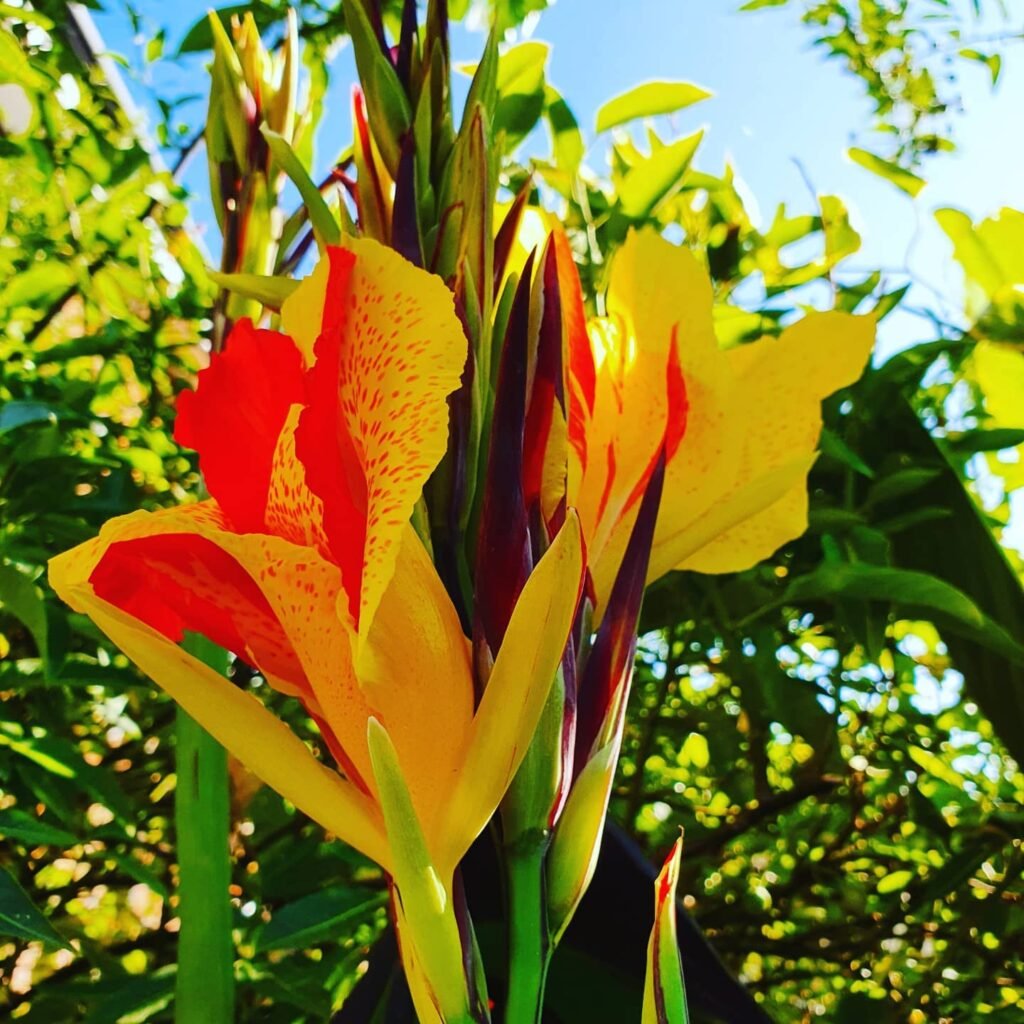
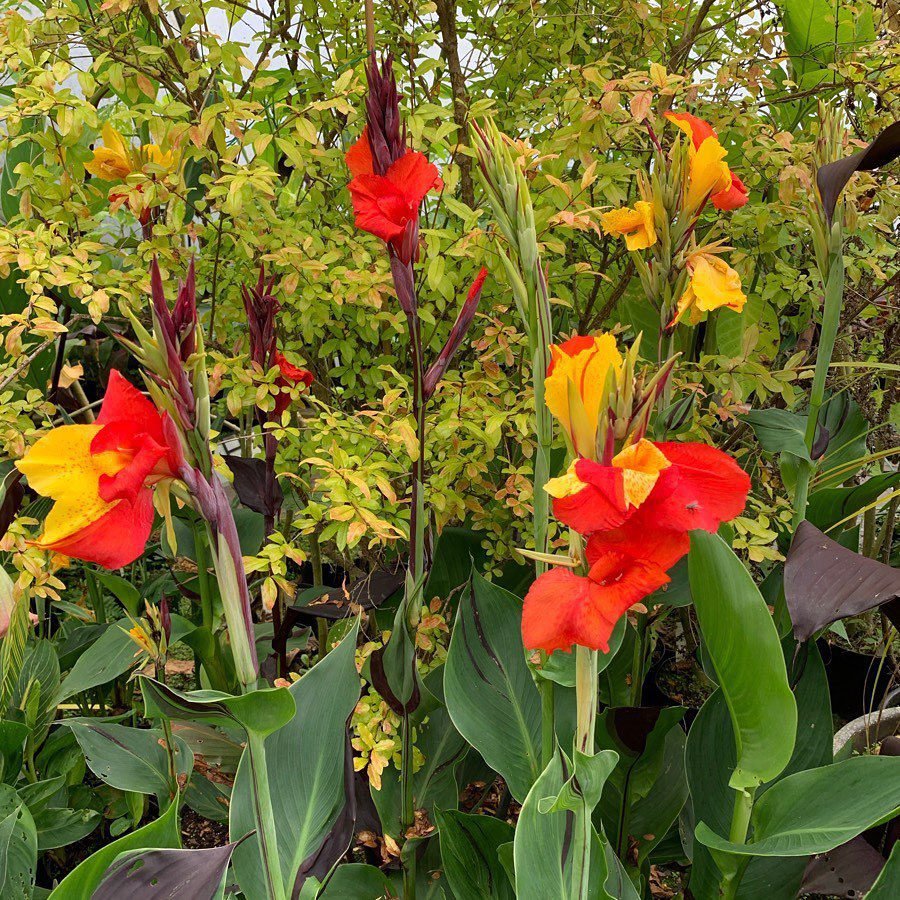
Propagating Canna ‘Cleopatra’ is a straightforward process that involves the division of rhizomes. During the spring, a time when the plant experiences active growth, I begin by carefully lifting the clump of rhizomes from the ground. The key is to divide the clump into smaller sections, making sure that each division has at least 2-3 growing points, which are essential for the development of new plants.
Once divided, I plant these rhizomes in well-prepared soil, spacing them approximately 60-90 cm (2-3 feet) apart. This ensures that each plant has enough room to grow and thrive. After planting, providing them with adequate water and care is crucial to help them establish. It’s important to highlight that attempting to grow Canna ‘Cleopatra’ from seed might not yield plants that are true to the characteristics of the parent variety. Therefore, division of rhizomes is the preferred and recommended method of propagation for maintaining the unique qualities of Canna ‘Cleopatra’.
This method not only ensures the continuation of the plant’s striking appearance but also allows for the easy expansion of its presence in the garden. By dividing and replanting the rhizomes, I can enjoy the spectacular display of Canna ‘Cleopatra’ in more areas of my garden, sharing its beauty and vibrant colours throughout.

Repotting Tips for Canna ‘Cleopatra’
If you’re growing Canna ‘Cleopatra’ in containers, it’s important to choose a large pot that can accommodate the plant’s size. These plants put on substantial growth in one season, and smaller pots can quickly become crowded.
When it’s time to repot, use a well-draining potting mix to ensure proper moisture levels for the plant. Make sure the pot you choose has drainage holes to prevent waterlogged soil, which can lead to root rot.
Repotting the plant every 1-2 years, or as needed, is recommended to prevent the accumulation of old, depleted soil. During the repotting process, be careful not to disturb the roots excessively.
After repotting, provide the canna ‘Cleopatra’ with proper water, ensuring the soil is evenly moist, but not overly wet. Regularly fertilize the plant with a balanced fertilizer to support healthy growth in the new container.
Remember, for healthy and vibrant canna ‘Cleopatra’ plants, choose a spacious pot, use well-draining soil, repot as needed, and provide proper water and fertilizer. This will help ensure your container-grown canna ‘Cleopatra’ thrives in your garden or patio space.
 Did you know that Canna ‘Cleopatra’ is a bit of a chameleon in the garden? Its leaves and blooms can change appearance, showing different patterns and colours on each plant and even on each leaf or flower. This makes every Canna ‘Cleopatra’ uniquely beautiful, with no two plants looking exactly the same. It’s a true standout that adds a touch of unpredictability and exotic charm to any garden.
Did you know that Canna ‘Cleopatra’ is a bit of a chameleon in the garden? Its leaves and blooms can change appearance, showing different patterns and colours on each plant and even on each leaf or flower. This makes every Canna ‘Cleopatra’ uniquely beautiful, with no two plants looking exactly the same. It’s a true standout that adds a touch of unpredictability and exotic charm to any garden.
Best Canna ‘Cleopatra’ Varieties to Grow
Canna lilies, with their vibrant blooms and lush foliage, are a cornerstone of any tropical or exotic-themed garden. While Canna ‘Cleopatra‘ is a standout variety for its unique colouration and semi-dwarf stature, there are several other varieties that also bring their own distinct appeal to the garden.
- Canna ‘Tropicanna’: This variety is renowned for its striking foliage, which features bold stripes of red, yellow, pink, and green. The flowers of ‘Tropicanna’ are equally vibrant, displaying a rich orange hue that contrasts beautifully against the foliage. For a gardener looking to introduce a splash of colour and texture, ‘Tropicanna’ offers an eye-catching display.
- Canna ‘Stuttgart’: A unique variety known for its variegated foliage, ‘Stuttgart’ presents leaves splashed with white and green. This striking variegation can be a light-catching focal point in any garden. The flowers, typically orange in colour, add a lovely contrast to the unique foliage. ‘Stuttgart’ is ideal for gardeners who appreciate foliage as much as flowers.
- Canna ‘Black Knight’: For those who favour deeper tones, ‘Black Knight’ offers dark, burgundy-red flowers that appear almost black in certain lights. Its foliage, a deep green sometimes edged with bronze, provides a dramatic backdrop for the blooms. This variety can add a touch of sophistication and mystery to your garden.
- Canna ‘Yellow King Humbert’: Boasting bright yellow flowers that are flecked with orange, this variety shines brightly in any garden. Its broad, green leaves make the yellow blooms stand out even more. ‘Yellow King Humbert’ is perfect for adding a sunny, cheerful atmosphere to your outdoor space.
- Canna ‘Pink Sunburst’: This variety features salmon-pink flowers that can brighten up any garden corner. The foliage is also noteworthy, with green leaves streaked with pink and yellow, adding to its overall attractiveness. ‘Pink Sunburst’ is ideal for creating a soft, warm feel in the garden.
For new gardeners interested in adding canna lilies to their gardens, it’s encouraging to know that these plants are relatively easy to care for, requiring just a sunny spot and moist, well-drained soil to thrive. Each variety mentioned brings its own unique beauty and can be used to create a stunning visual impact in the garden, from tropical vibrancy to elegant sophistication.
Incorporating different varieties of canna lilies into your garden not only adds diversity in height, colour, and texture but also allows you to experiment with design, creating a garden that is truly your own. Whether you’re drawn to the fiery hues of ‘Cleopatra’ and ‘Tropicanna’, the elegant darkness of ‘Black Knight’, or the cheerful brightness of ‘Yellow King Humbert‘ and ‘Pink Sunburst’, there’s a canna lily variety to suit any gardener’s taste and garden’s theme.
Helpful Videos about Growing Your Canna ‘Cleopatra’
Fancy growing a Canna ‘Cleopatra’ in your garden? I’ve found some great videos to help you out. They’re full of simple tips to help your plant do well, from the basics to a few handy hints. Whether you’re new to gardening or have been at it for a while, these videos will make looking after your Canna ‘Cleopatra’ straightforward and fun.
- EASY planting Canna Lilly (Cleopatra)
FAQ about Growing Canna ‘Cleopatra’ (Canna Lily)

Keen on turning your Canna ‘Cleopatra’ (Canna Lily) into the jewel of your garden? Dive into my specially crafted FAQ where I spill all the secrets for nurturing your Canna ‘Cleopatra’. From the ideal sunlight exposure to the best watering practices, I’ve got you covered, ensuring your plant doesn’t just grow, but flourishes.
Canna ‘Cleopatra’ thrives in a sunny or partially shaded spot. They adore the sun, so the more, the better for vibrant blooms.
Water your plant generously during the growing season, especially during dry spells. Ensure the soil is moist but not waterlogged.
They prefer rich, well-drained soil. Adding garden compost or well-rotted manure boosts their growth.
Plant them in spring, after the last frost, to give them a good start.
Plant them about 5-10 cm deep with the eyes (shoots) facing upwards.
Space them 45-60 cm apart to allow room for growth.
Yes, feed them with a high-potassium fertiliser every 4 weeks during the growing season to encourage blooming.
They can reach a height of 90-120 cm.
Absolutely, they do well in large pots with drainage holes. Just ensure they’re well watered.
Keep an eye out for slugs, snails, and red spider mites. Regular checks will help prevent infestations.
Yellow leaves can be a sign of overwatering or poor drainage. Ensure the soil is moist but not soggy.
Ensure they’re in a sunny spot and feed regularly with a potassium-rich fertiliser during the growing season.
Legginess can be due to too much shade. Move them to a sunnier spot if possible.
Repot every couple of years or when they become root-bound to give them more room to grow.
They can be started off indoors early in the year but prefer to be outside during the summer months for the best blooms.
I hope this has cleared up how to care for your Canna ‘Cleopatra’ plant. Any more questions? Just drop them in the comments, and I’ll answer. Remember, everyone starts somewhere, and learning about your garden is a great journey.
Conclusion
Growing and caring for Canna ‘Cleopatra’ can be a rewarding experience for UK gardeners. By following the care tips mentioned in this article, you can ensure that your Canna ‘Cleopatra‘ plants thrive in the UK climate, producing vibrant blooms and lush tropical foliage. From providing the right light and water requirements to maintaining proper soil fertility and practicing regular maintenance, taking care of Canna ‘Cleopatra’ can result in a stunning addition to your garden.
With its stunning appearance and unique features, Canna ‘Cleopatra’ is sure to captivate garden enthusiasts. These exotic garden flowers with their tropical foliage can add a touch of elegance and sophistication to any outdoor space. Whether you choose to plant them in the ground or in containers, Canna ‘Cleopatra’ will instantly elevate the beauty of your garden.
So, if you’re searching for a show-stopping plant that is sure to make a statement, look no further than Canna ‘Cleopatra’. With its vibrant colors, striking blooms, and lush foliage, this canna lily variety is a must-have for any UK gardener. Follow these care tips, embrace your green thumb, and enjoy the beauty and uniqueness of Canna ‘Cleopatra’ in your own outdoor oasis.

